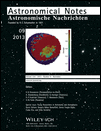Observability of YSOs with the WISE and AKARI infrared space observatories
Corresponding Author
S. Zahorecz
Loránd Eötvös University, Department of Astronomy, Pázmány Péter sétány 1, 1117 Budapest, Hungary
Loránd Eötvös University, Department of Astronomy, Pázmány Péter sétány 1, 1117 Budapest, HungarySearch for more papers by this authorL.V. Töth
Loránd Eötvös University, Department of Astronomy, Pázmány Péter sétány 1, 1117 Budapest, Hungary
Search for more papers by this authorG. Marton
Konkoly Observatory, Research Centre for Astronomy and Earth Sciences, Hungarian Academy of Sciences, 1121 Budapest, Konkoly Thege Miklós út 15-17, Hungary
Search for more papers by this authorM. Ueno
Japan Aerospace Exploration Agency (JAXA), 3-1-1 Yoshinodai, Sagamihara, Kanagawa 229-8510, Japan
Search for more papers by this authorM. Tamura
National Astronomical Observatory of Japan, 2-21-1 Osawa, Mitaka, Tokyo 181-8588; The Graduate University for Advanced Studies (SOKENDAI), 2-21-1 Osawa, Mitaka, Tokyo 181-8588, Japan
Search for more papers by this authorA. Kawamura
Department of Astrophysics, Nagoya University, Chikusa-ku, Nagoya 464-8602, Japan
Search for more papers by this authorY. Kitamura
Institute of Space and Astronautical Science, Japan Aerospace Exploration Agency, 3-1-1 Yoshinodai, Sagamihara, Kanagawa 229-8510, Japan
Search for more papers by this authorCorresponding Author
S. Zahorecz
Loránd Eötvös University, Department of Astronomy, Pázmány Péter sétány 1, 1117 Budapest, Hungary
Loránd Eötvös University, Department of Astronomy, Pázmány Péter sétány 1, 1117 Budapest, HungarySearch for more papers by this authorL.V. Töth
Loránd Eötvös University, Department of Astronomy, Pázmány Péter sétány 1, 1117 Budapest, Hungary
Search for more papers by this authorG. Marton
Konkoly Observatory, Research Centre for Astronomy and Earth Sciences, Hungarian Academy of Sciences, 1121 Budapest, Konkoly Thege Miklós út 15-17, Hungary
Search for more papers by this authorM. Ueno
Japan Aerospace Exploration Agency (JAXA), 3-1-1 Yoshinodai, Sagamihara, Kanagawa 229-8510, Japan
Search for more papers by this authorM. Tamura
National Astronomical Observatory of Japan, 2-21-1 Osawa, Mitaka, Tokyo 181-8588; The Graduate University for Advanced Studies (SOKENDAI), 2-21-1 Osawa, Mitaka, Tokyo 181-8588, Japan
Search for more papers by this authorA. Kawamura
Department of Astrophysics, Nagoya University, Chikusa-ku, Nagoya 464-8602, Japan
Search for more papers by this authorY. Kitamura
Institute of Space and Astronautical Science, Japan Aerospace Exploration Agency, 3-1-1 Yoshinodai, Sagamihara, Kanagawa 229-8510, Japan
Search for more papers by this authorAbstract
Large area surveys allow us to identify young stellar objects and classify them based on their colours. The near-, mid- and far-infrared filters' sensitivities are different, therefore different proportions of young stars are observable. Evolutionary times for the different classes can be concluded from the popularity of the classes. Our aim was to investigate the completeness of the YSO detections. With the use of only mid- or only far-infrared surveys, we will miss one part of the young stellar objects. Without far-infrared data one third of the Class 0–II objects can remain invisible. Class III sources are almost invisible above 65 μm. For a comprehensive study we have to use the available data in the whole infrared range. (© 2013 WILEY-VCH Verlag GmbH & Co. KGaA, Weinheim)
References
- Adams, F.C., Lada, Ch.J., & Shu, F.H. 1987, ApJ, 312, 788
- Adams, F.C., & Shu, F.H. 1988, Infrared Spectra of Young Stellar Objects, in Comets to Cosmology, ed. A. Lawrence, LNP 297 (Springer-Verlag, Berlin), 164
- Andrews, S.M., & Williams, J.P. 2005, ApJ, 631, 1134
- Beckwith, S.V.W., & Sargent, A.I. 1991, ApJ, 381, 250
- Cutri, R.M., Skrutskie, M.F., van Dyk, S., et al. 2003, 2MASS All Sky Catalog of point sources, NASA/IPAC Infrared Science Archive
- Cutri, R.M., et al. 2012, WISE All-Sky Data Release, NASA/IPAC Infrared Science Archive, 2012yCat,2311,0C
- Emerson, J.P. 1987, IRAS and Star Formation in Dark Clouds, in Star Forming Regions, ed. M. Peimbert, & J. Jugaku, IAU Symp. 115 (D. Reidel Publishing Co., Dordrecht), 19
- Evans, N.J.II, Allen, L. E., Blake, G.A., & Boogert, A.C.A. 2003, PASP, 115, 965
- Evans, N.J.II, Dunham, M. M., Jorgensen, J.K., et al. 2009, ApJS, 181, 321
- Franceschini, A., Cesarsky, C., & Rowan-Robinson, M. 1995, Mem. Soc. Astron. Ital., 66, 717
- Hoffmann, W.F., Woolf, N.J., & Frederick, C.L. 1967, Sci, 157, 3785 , 187
- Juvela M., Ristorcelli, I., Pagani, L., et al. 2012, A&A, 541, 12
- Kawada, M., Baba, H., Barthel, P.D., et al. 2007, PASJ, 59, S389
- Koenig, X.P., Leisawitz, D. T., Benford, D.J., et al. 2012, ApJ, 744, 130
- Lada, Ch.J. 1987, Star formation – From OB Associations to Protostars, in Star Forming Regions, ed. M. Peimbert, & J. Jugaku, IAU Symp. 115 (D. Reidel Publishing Co., Dordrecht), 1
- Lada, Ch.J., & Adams, F.C. 1992, ApJ, 393, 278
- Lee, H.-T., & Chen, W. P. 2002, Near-Infrared Colors of Young Stellar Objects, in The Proceedings of the IAU 8th Asian-Pacific Regional Meeting, Vol. II, ed. S. Ikeuchi, J. Hearnshaw, & T. Hanawa (Astronomical Society of the Japan, Tokyo), 161
- Monet, D-G., Levine, S.E., Canzian, B., et al. 2003, AJ, 125, 984
- Murakami, H., Baba, H., Barthel, P., et al. 2007, PASJ, 59, S369
- Myers, P.C., Fuller, G.A., Mathieu, R.D., et al. 1987, ApJ, 319, 340
- Neugebauer, G., & Leighton, R.B. 1969, Two-Micron Sky Survey; a Preliminary Catalog, NASA SP 3047 (Scientific and Technical Information Division, Washington)
- Onaka, T., Matsuhara, H., Wada, T., et al. 2007, PASJ, 59, 401
- Pezzuto, S., Grillo, F., Benedettini, M., et al. 2002, MNRAS, 330, 1034
- Robitaille, T.P., Whitney, B.A., Indebetouw, R., Wood, K., & Denzmore, P. 2006, ApJS, 167, 256
- Robitaille, T.P., Whitney, B.A., Indebetouw, R., & Wood, K. 2007, ApJS, 169, 328
- Werner, M.W., Roellig, T.L., Low, F.J., et al. 2004, ApJS, 154, 1
- Whitney, B.A., Wood, K., Bjorkman, J.E., & Wolff, A.J. 2003, ApJ, 591, 1049
- Wright, E.L., Eisenhardt, P.R.M., Mainzer, A.K., et al. 2010, AJ, 140, 1868
- Yamamura, I., Makiuti, S., Ikeda, N., et al. 2010, yCat 2298, 0
- Zahorecz, S., et al., in prep.




